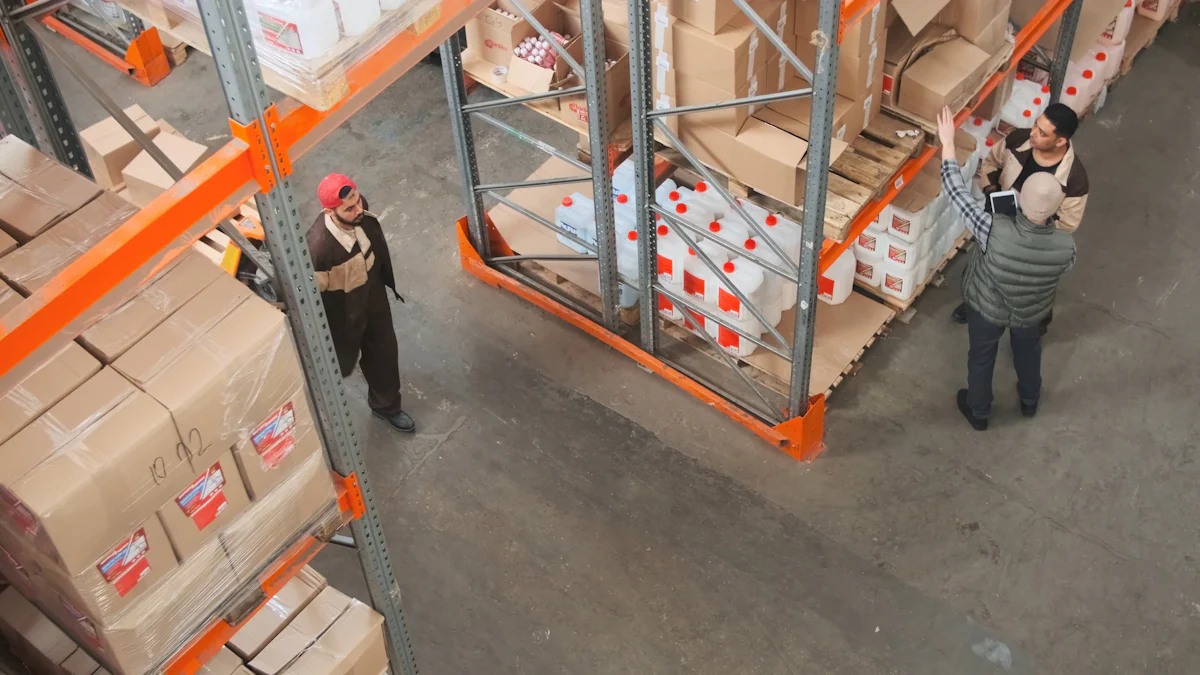The Benefits of Real-Time Data for Managing Your Flashlight Supply Chain

Real-time data transforms how you manage your flashlight supply chain. It empowers you to make faster, smarter decisions that drive efficiency and customer satisfaction. Companies with real-time visibility report up to 79% better supplier performance and reduce operational lag times by 30%. You can also cut costs by 15% and improve inventory turnover by 14%. Real-time tracking ensures shipments move quickly, reducing delays by 58%. These benefits help you meet growing consumer demands, like same-day delivery, while enhancing trust and transparency. The Benefits of Real-Time Data for Managing Your Flashlight Supply Chain are undeniable.
Key Takeaways
Real-time data helps you work smarter by making better choices. It lets you act fast when markets or customer needs change.
Using real-time data can cut costs by up to 30%. This saves money and helps you use resources wisely.
Real-time tracking gives you a clearer view of logistics. You can watch shipments and change routes to avoid being late.
Real-time data makes customers happier. It gives accurate delivery updates and helps you talk to them early, building trust.
Getting the right tools and teaching your team is important. This helps everyone use real-time data to improve supply chains.
How Real-Time Data Improves Decision-Making in the Flashlight Supply Chain

Accurate Demand Forecasting
Real-time data allows you to predict demand fluctuations with greater accuracy. By analyzing market trends and customer behavior instantly, you can adjust production schedules and inventory levels proactively. This reduces the risk of stockouts or overstock situations. A Harvard Business Review report highlights that businesses using real-time insights achieve a 15% reduction in operational costs and a 14% improvement in inventory turnover. These improvements enhance cash flow and product availability, giving you a competitive edge in the flashlight market. With real-time data processing, you can stay ahead of demand changes and meet customer expectations effectively.
Optimized Resource Allocation
Real-time data streaming enhances your ability to allocate resources efficiently. AI-powered tools analyze historical and live data to identify patterns in customer behavior. This enables you to adjust resource allocation dynamically based on changing conditions. For example, AI can optimize inventory levels or reassign delivery vehicles in response to unexpected disruptions. Companies leveraging real-time data have reduced response times to supply chain disruptions by 50%. Additionally, 70% of supply chain professionals report that improved visibility helps them manage risks proactively. These capabilities ensure you use resources effectively, minimizing waste and maximizing efficiency.
Enhanced Logistics and Distribution
Real-time data transforms logistics and distribution by providing continuous visibility into your operations. You can track shipments, monitor delivery routes, and adjust plans dynamically. For instance, GPS tracking and traffic monitoring enable you to optimize delivery routes, reducing delays and fuel costs. Companies like Maersk and Unilever use real-time tracking systems to ensure timely deliveries and improve efficiency. Automated warehouse management systems, powered by real-time updates, enhance inventory accuracy and reduce manual errors. These advancements not only lower logistics costs but also improve customer satisfaction by ensuring timely and reliable deliveries.
The Benefits of Real-Time Data for Managing Your Flashlight Supply Chain
Improved Supply Chain Transparency
Real-time data enhances supply chain transparency by providing instant insights into operations. You can monitor activities continuously and address issues before they escalate. This visibility improves inventory management and forecasting accuracy, helping you optimize efficiency and reduce costs. With real-time updates, you gain complete end-to-end transparency, allowing all stakeholders to stay informed. This capability also helps you address long-term challenges, such as shipping delays, by identifying root causes early.
Transparency improves planning capabilities by increasing the accuracy of information. Immediate updates on order backlogs enhance logistics and inventory management. Managers can analyze operations in real time to reduce waiting times, leading to a better customer experience. By leveraging real-time data, you can achieve supply chain optimization and build trust with your partners and customers.
Cost Reduction and Efficiency Gains
Real-time data streaming plays a crucial role in reducing costs and improving efficiency. Businesses using real-time data have reduced response times to supply chain disruptions by 50%. Advanced analytics solutions help lower inventory holding costs by up to 20%. These savings allow you to allocate resources more effectively and invest in other areas of your business.
Dynamic route adjustments, enabled by real-time data, help you avoid delays and cut fuel costs. Tracking goods at every stage of the supply chain ensures timely demand fulfillment, minimizing time-to-market. Anticipating demand fluctuations allows for faster decision-making, which reduces waste and boosts operational efficiency. These cost-saving measures make your flashlight supply chain more resilient and competitive.
Better Customer Satisfaction
Real-time data improves customer satisfaction by enabling proactive communication and personalized experiences. For example, e-commerce companies use real-time tracking to send automated notifications at key stages of delivery. This approach reduces uncertainty and builds trust. C&S Wholesale Grocers, for instance, decreased transportation-related customer service calls by 65% within four months of implementing automated notifications.
Meeting customer expectations becomes easier with real-time data. You can provide accurate shipping updates and adapt quickly to changes. Studies show that 52% of consumers prefer orders to arrive within 2-3 days. Real-time data helps you meet these expectations by streamlining operations and resolving issues proactively. By enhancing customer trust and loyalty, you gain a competitive edge in the flashlight market.
Implementing Real-Time Data Solutions in Your Flashlight Supply Chain

Selecting the Right Tools and Technologies
Choosing the right tools and technologies is essential for integrating real-time data into your flashlight supply chain. Start by evaluating solutions that enhance supply chain visibility and operational efficiency. Tools like GPS tracking provide precise shipment location data, enabling you to monitor delivery progress and address potential delays. ERP systems centralize core processes such as inventory management and order fulfillment, ensuring seamless operations. Real-time analytics platforms track metrics like inventory levels and transit times, allowing proactive decision-making.
Investing in AI and machine learning further enhances your ability to analyze data and identify trends. These technologies improve real-time inventory management and real-time order routing, helping you respond quickly to market changes. Regularly updating your systems ensures data accuracy and security, which are critical for maintaining supply chain agility. By leveraging these tools, you can optimize processes, reduce costs, and improve customer satisfaction.
Training Teams for Data-Driven Operations
Your team plays a pivotal role in implementing real-time data solutions effectively. Continuous training ensures employees understand how to use data streaming tools and analytics platforms. Training programs should focus on building skills for data-driven decision making and fostering a culture of critical thinking. Inspection teams equipped with real-time insights can combine local knowledge with technology to enhance supply chain operations.
To create a data-driven culture, encourage curiosity and provide opportunities for employees to develop data skills. Executive advocacy and community support further reinforce the importance of data-driven decisions.
Using integration platforms that unify various functions into a cohesive system simplifies operations for your team. This approach ensures everyone can access real-time data and make informed decisions. With proper training, your team becomes a valuable asset in achieving supply chain efficiency.
Building Partnerships with Reliable Data Providers
Collaborating with reliable data providers strengthens your flashlight supply chain. Strong partnerships streamline operations, reduce waste, and improve customer satisfaction. Open communication channels and real-time data sharing foster collaboration. Setting shared goals and performance metrics ensures alignment between you and your partners.
Trust is another critical factor. Building strong relationships with suppliers enables effective problem-solving and risk management. Reliable data providers help you identify and mitigate risks, ensuring consistent supply chain performance. By prioritizing collaboration and trust, you can create a resilient and efficient supply chain.
Addressing Challenges in Adopting Real-Time Data
Managing Implementation Costs
Adopting real-time data solutions involves significant financial investment. You need to account for costs such as purchasing technology, software subscriptions, and system integration. Training employees to use these tools and maintaining the systems also add to the expenses. For example, sensors and IoT devices provide critical data, but they require upfront purchases. Software platforms often come with recurring subscription fees. Integration with existing systems ensures seamless operations but can be resource-intensive.
Cost Component | Description |
|---|---|
Technology Purchases | Costs for sensors and IoT devices |
Software Subscriptions | Ongoing fees for software used in data solutions |
Integration | Expenses related to integrating new systems |
Employee Training | Investment in training programs for staff |
Ongoing Maintenance | Regular costs for maintaining the systems |
To manage these costs, focus on scalable infrastructure and efficient resource allocation. Real-time tracking optimizes delivery routes, reducing fuel costs. Enhanced visibility prevents overstocking, saving money on inventory management. Identifying inefficiencies allows you to make swift adjustments, minimizing waste and improving operational efficiency.
Handling Data Overload
Real-time data systems generate vast amounts of information, which can overwhelm your supply chain operations. Integrating data from diverse sources is complex, especially when multiple platforms are involved. Latency issues and synchronization challenges further complicate the process. To prevent overload, implement scalable infrastructure that adjusts resources based on demand. Data partitioning divides information into manageable chunks, enabling parallel processing. Efficient data processing techniques and real-time analytics help monitor streams and identify potential bottlenecks. These strategies ensure your supply chain remains agile and responsive.
Ensuring Data Accuracy and Security
Accurate and secure data is essential for effective supply chain management. Select reliable data sources and standardize formats to simplify integration. Regularly monitor data quality to identify errors or inconsistencies. Data governance establishes clear ownership, ensuring accountability. Leverage tools to detect and correct duplicates or outliers.
Security is equally important. Advanced encryption safeguards sensitive information from breaches. Train employees in data literacy to enhance decision-making and reduce risks. Integrating data streams provides a comprehensive view, improving both security and operational efficiency. These practices protect your supply chain from disruptions and maintain customer trust.
Real-time data transforms your flashlight supply chain by improving decision-making, reducing costs, and enhancing customer satisfaction. It helps you identify inefficiencies, optimize inventory, and improve transparency. With predictive analytics, you can anticipate demand, reduce waste, and respond swiftly to market changes. These capabilities give you a competitive edge in a dynamic market. Businesses using real-time data report better planning, faster responses to disruptions, and improved customer experiences. Adopting these solutions now ensures long-term benefits like cost savings, operational efficiency, and increased trust. Take action today to future-proof your supply chain and stay ahead of the competition.
FAQ
What is real-time data in supply chain management?
Real-time data refers to information collected and updated instantly. It allows you to monitor and manage supply chain activities as they happen. This ensures faster decision-making and improved efficiency.
How does real-time data reduce costs in the flashlight supply chain?
Real-time data helps you optimize inventory, reduce waste, and streamline logistics. By tracking shipments and adjusting routes dynamically, you save on fuel and storage costs.
Can small businesses benefit from real-time data solutions?
Yes, small businesses can use real-time data to improve inventory management, reduce delays, and enhance customer satisfaction. Scalable tools make it affordable and accessible for businesses of all sizes.
What tools are essential for implementing real-time data?
Key tools include GPS tracking systems, ERP software, and analytics platforms. These technologies provide visibility, streamline operations, and enable proactive decision-making.
How does real-time data improve customer satisfaction?
Real-time data enables accurate delivery updates and faster issue resolution. Customers receive timely notifications and reliable service, which builds trust and loyalty.
See Also
Understanding Wholesale Flashlight Advantages and Cost Savings
Successful Marketing Approaches for Wholesale Flashlight Sales
Exploring Future Trends in Flashlight Demand Across Markets
